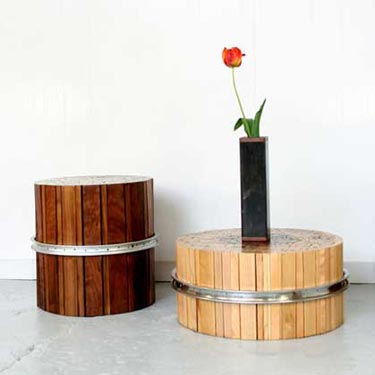How to Construct High Quality Furniture Using Reclaimed Wood
December 8, 2010 -from wikiHow - The How to Manual That You Can Edit
Steps

Reclaimed Wood Furniture
- The first and possibly most important step in the construction of reclaimed wood furniture is the choice of the wood, and the style of construction. There are many different species of reclaimed wood indigenous to the American landscape, and all have different qualities. Also, there are many different construction techniques that are time tested methods and styles. Often the choice of the style of furniture helps to dictate the type of wood used. Maple, Beech, and Walnut seem to be the most often used woods for Contemporary reclaimed furniture, while Oak, Poplar, and Cherry seem to follow more closely with the rustic style.
- Always kiln dry reclaimed barn lumber (or any lumber for that matter). Kiln drying lumber properly is not an option, it is a MUST! The process of kiln drying involves stacking lumber on 1"x1" sticks in bundles, in an air tight room. Once the lumber is in the "kiln", heat is added slowly until the ambient temperature reaches around 140 degrees f. While the lumber is being heated, it is releasing moisture. Where does that moisture go if the room is airtight? In order to dry reclaimed wood properly to be used for your furniture, you have to have a commercial dehumidifier to draw the moisture from the wood and essentially dry it. Most species of reclaimed wood have an equilibrium moisture content of around 6-8%. It is crucial to get the wood to this moisture, because if it is higher than this, the wood still has moisture inside, that will cause the wood to shrink once in climate control.
- The kiln drying process is also required to kill the bugs and micro-organisms inside reclaimed lumber. The recommended process to eliminate insects is to heat the core of the wood to 140 degrees f for 4 hours.
- Begin construction of the furniture. The first process to construction is to have a plan for the piece you are building. This plan, or "shop drawing" can be a simple sketch, or a complex drawing from an architect or designer. No matter the project, this simple step helps assure that you will not make mistakes.
- Metal detect the lumber. This is highly important because one nail in a board can cause very painful and costly damage to machinery. Use whatever means possible to remove the metal without damaging the wood.
- Rough mill the lumber is the next process. This is the process of cutting to rough length (not finished length), and sizing to width. We typically use reclaimed lumber that has similar color or grain characteristics. Once the lumber is selected, The material needs to be face and edge jointed, then planed to thickness (unless you prefer the original surface of your boards).
- After your reclaimed lumber is dimensioned (edge joined, and planed to size), you can now start assembly by edge gluing your boards together for the given panels you will need. Once panels have dried from gluing and clamping them together, run them through a wide belt sander to flatten the table, and to sand it smooth. If you don't have access to a wide belt sander, a simple dual action palm sander will do, but it will take you hours.
- Begin final assembly. Depending on the type of furniture you are building, you have many options for joinery. For our knock down furniture, use simple butt-joints, insert nuts, and screws, for our more complex and custom furniture, use mortise and tenon, dovetails, and dutchman joinery techniques. The rule to woodworking is to anticipate wood movement. Wood will expand and contract from season to season, so never ever ever attempt to try and keep wood from moving. Always allow for movement, and your furniture will look great for generations.
- After sanding and final assembly, the finish work can take place. If building multiple tables at a time, use a spray gun to apply finish. It is not only faster, but it is much easier and less messy. If you do not have a spray gun, you can hand apply most finishes unless they are catalyzed. Try low VOC commercial grade lacquer. You can also use hand rubbed tung oil before you spray, with pretty good results, although the oils can sometimes take 4 or more applications to actually get a sheen. Once you have completed your finish, a nice wax coat is the icing on the cake. Try steel wool with #0000, and rub the wax in, let stand, then buff out.
Tips
- Be patient. If you have no patience, the wood will work you instead of vice/versa.
- Always kiln dry.
- Use high quality finish, not the cheap stuff you get at the big retail stores.
- Enjoy your furniture.
Warnings
- Do not work with non kiln-dried lumber. It doesn't matter how dry it appears or feels, unless it is kiln dried, it is not ready for use.
- Always apply finish in a well vented area.
- Watch your fingers, hair, and clothes around machinery...you don't want to be Johnny 3 finger!